Nature Photography by Richard L. Bowman
Flowers & Plants Blog
Flowers & Plants Blog
Today as I was driving down Waterman Drive here in Harrisonburg, I noticed a flower I would know anywhere even with my bad eyesight. This section of Waterman looks more like a country road than a city street.
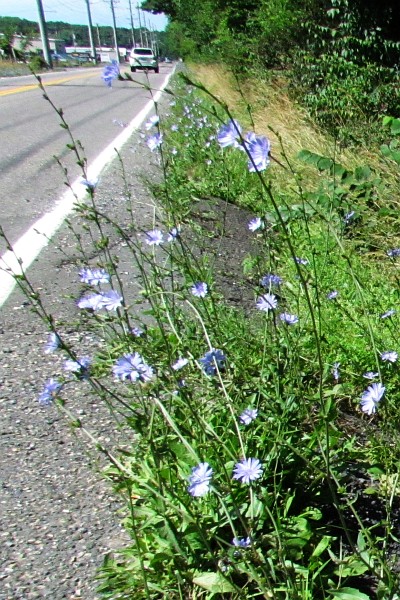
Chicory, along Waterman Drive, Harrisonburg, VA, USA (I) (29-Jun-13; © Richard L. Bowman)
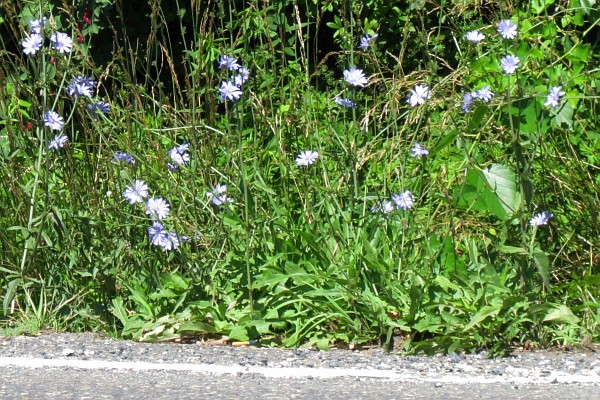
Chicory, along Waterman Drive, Harrisonburg, VA, USA (II) (29-Jun-13; © Richard L. Bowman)
I have not tried roasting the roots myself, but this is the item that is added to coffee to make it French Roast Coffee. But maybe our local chicory does not have the best flavor of that used by New Orleans coffee makes.
Here are a couple of photos showing the Chicory flower up close.
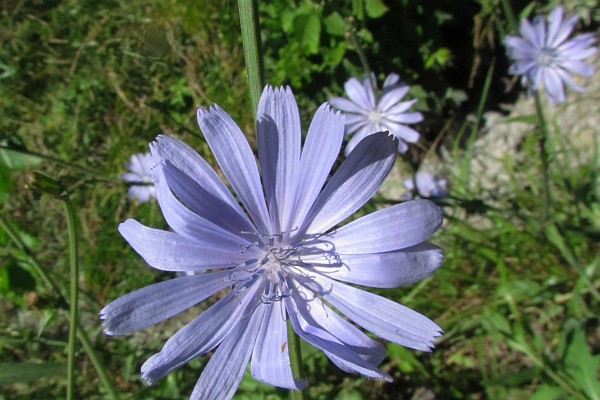
A Chicory Flower, Harrisonburg, VA, USA (29-Jun-13; © Richard L. Bowman)
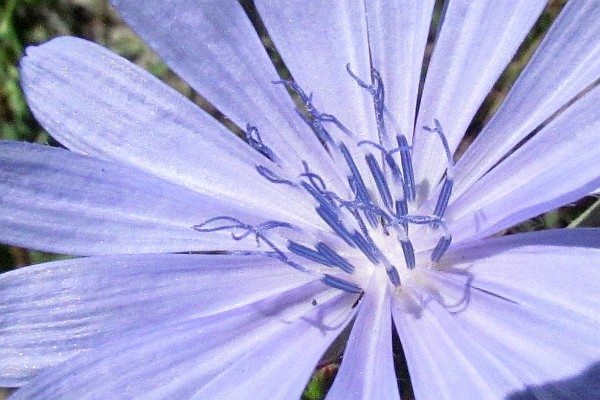
Close-up of a Chicory Flower, Harrisonburg, VA, USA (29-Jun-13; © Richard L. Bowman)
Today I also studied the Black-eyed Susan a bit closer than I have ever done. Our plant is climbing and producing oodles of lovely blooms.
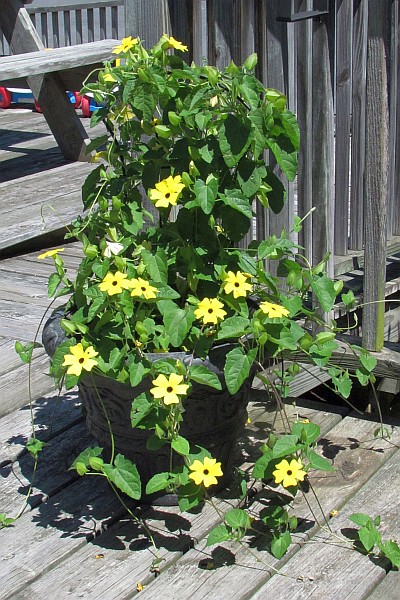
Black-eyed Susan Plant and Flowers, Harrisonburg, VA, USA (29-Jun-13; © Richard L. Bowman)
And one flower is a lovely and yet sometimes not quite symmetrical bloom with a black dot in the center.
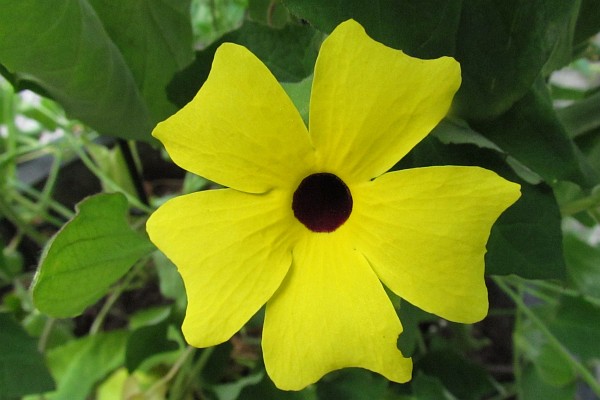
One Black-eyed Susan Flower, Harrisonburg, VA, USA (29-Jun-13; © Richard L. Bowman)
Today I was really curious about that black disk at the center of the flower. My close-up photographs only hinted at what I might be seeing, so I added the light from an LED flashlight to allow me to peer just a bit more deeply into the hole.
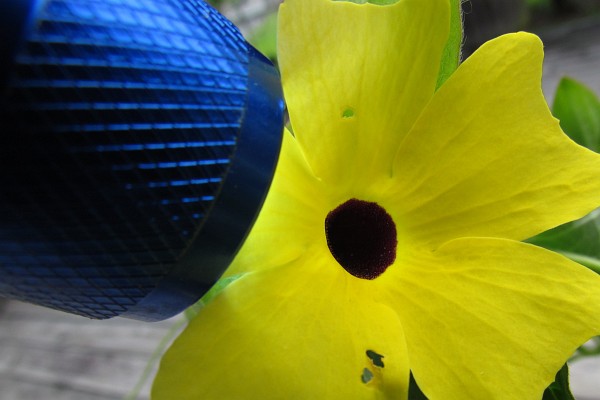
An LED Flachlight Shining onto a Black-eyed Susan Flower, Harrisonburg, VA, USA (29-Jun-13; © Richard L. Bowman)
And below is what my camera found. The black disk is really a black hole lined with hairs. So I'm guessing all of the reprotudctive activity and apparatus lies within this tube.
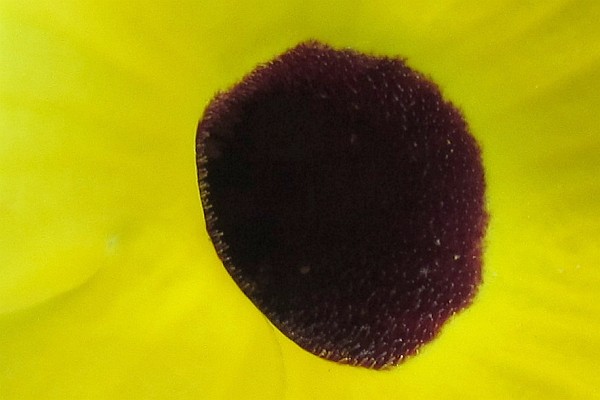
Close-up of Black-eyed Susan Flower Black Hole, Harrisonburg, VA, USA (29-Jun-13; © Richard L. Bowman)
To confirm that I was not simply looking at artifacts produced by my camera, I actually stuck a ball point pen into the hole and photographed it. (See the composite image below of the pen entering the hole.)
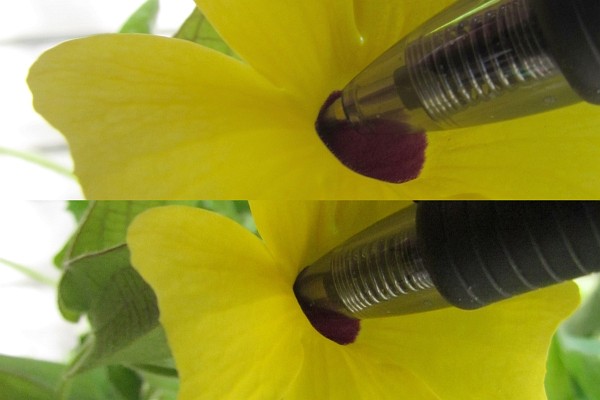
Close-up of Pen Entering Black-eyed Susan Black Hole, Harrisonburg, VA, USA (29-Jun-13; © Richard L. Bowman)
There is definitely always something more for me (and you ) to learn!
OK, I'll confess that there are no roses in today's post, but there are some very beautiful flowers. Oh, and there are not 12 photos but actually 13, a "baker's dozen."
To begin, let's observe two Plantains. No, not banana-like fruit that I loved fried when it is ripe. Mmm...thinking of ot makes me hungry! But back to the weeds/flowers, the first is Buckhorn Plaintain.

Buckhorn Plantain Flowers, Harrisonburg, VA, USA (22-Jun-13; © Richard L. Bowman)
Below is a photo showing the leaves (narrow about 6 inches long, more or less, with parallel veins) and the flowers.
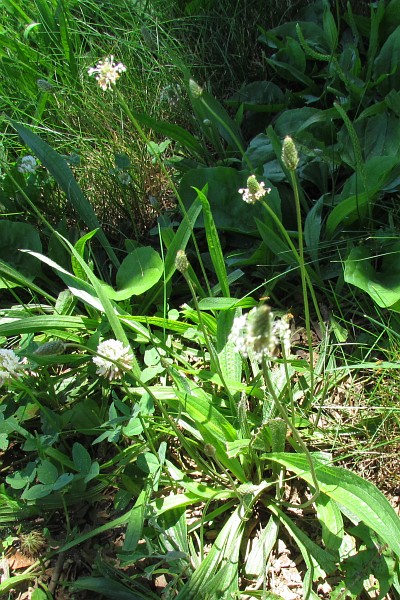
Buckhorn Plantains, Harrisonburg, VA, USA (22-Jun-13; © Richard L. Bowman)
The second plant is Broadleaf Plantain. The leaves are shorter and almost circular. As kids we called them "pig's ears."
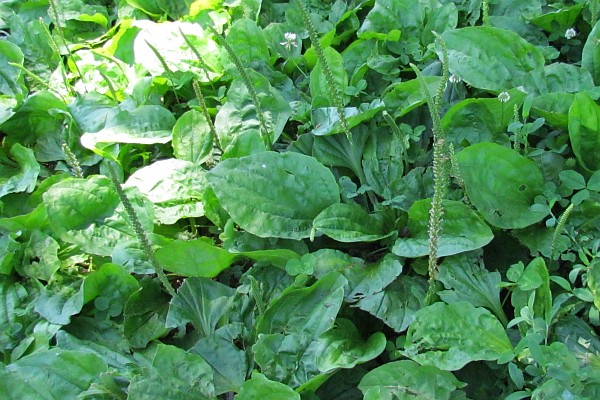
A Patch of Broadleaf Plantain at the Edge of Our Driveway, Harrisonburg, VA, USA (22-Jun-13; © Richard L. Bowman)
The multiple flowers are strung along a tall spike. Here is one where the flowers have not yet opened up.
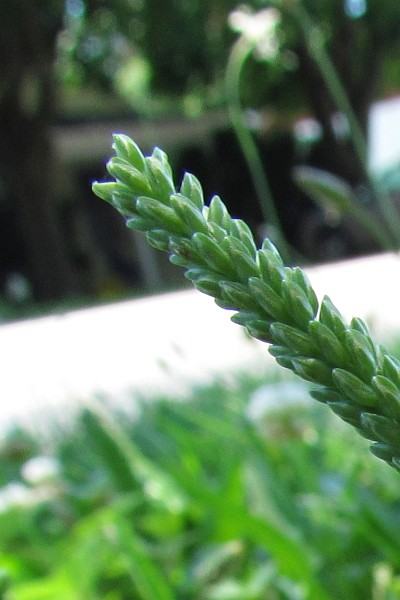
Flower Stalk of Broadleaf Plantain Not Yet Blooming, Harrisonburg, VA, USA (22-Jun-13; © Richard L. Bowman)
On the stalk below the flowers are beginning to open up.
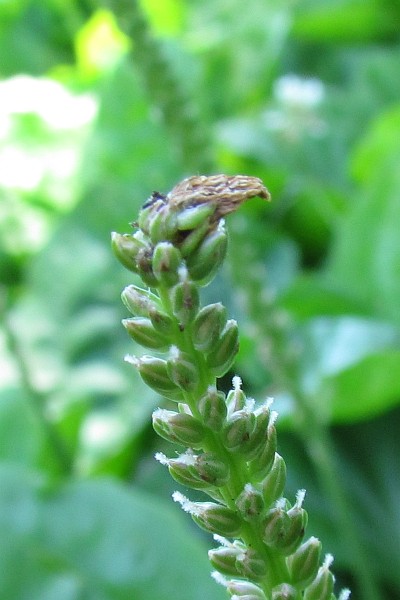
Tip of Broadleaf Plantain Beginning to Flower, Harrisonburg, VA, USA (22-Jun-13; © Richard L. Bowman)
This summer we have a very abundant row of Stella de Oro Daylily flowers. So let me post several photos for your enjoyment.
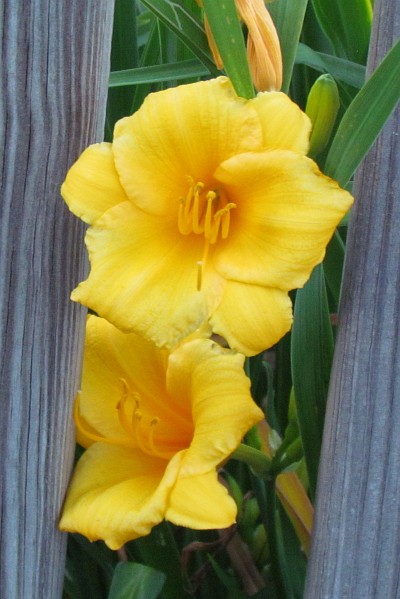
Two Stella de Oro Daylilies, Harrisonburg, VA, USA (22-Jun-13; © Richard L. Bowman)
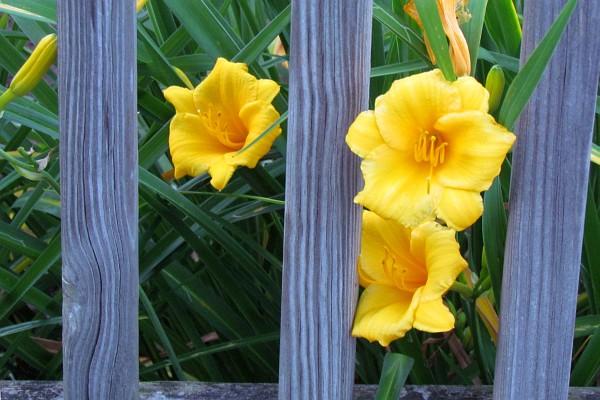
Three Stella de Oro Daylilies, Harrisonburg, VA, USA (22-Jun-13; © Richard L. Bowman)
Which one of the above two do you find most pleasing?
Below is half of our row of these beauties.
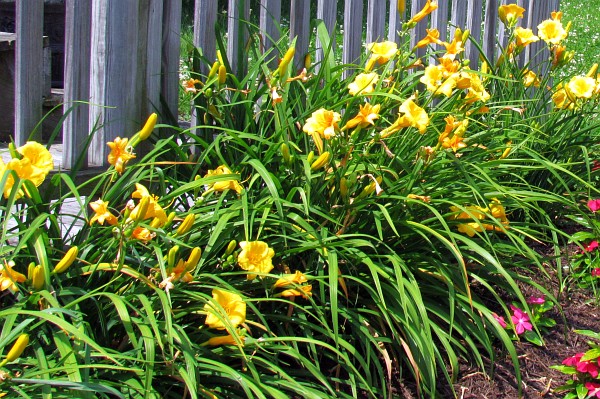
Half of the Row of Stella de Oro Daylilies by Our Deck , Harrisonburg, VA, USA (25-Jun-13; © Richard L. Bowman)
Up close they are fun to look at, too. This first one was taken at 10:19 a.m. EDT.
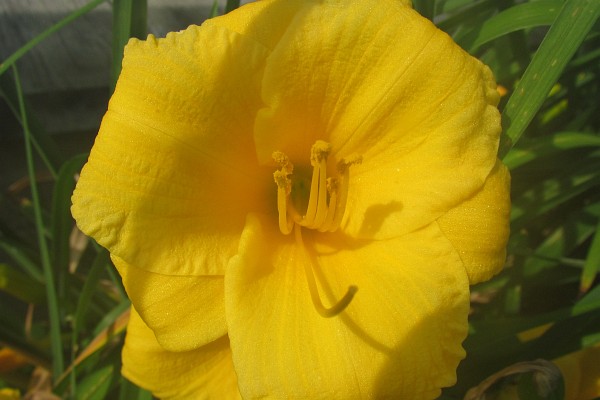
Close-up of Stella de Oro Daylily at 10 a.m., Harrisonburg, VA, USA (26-Jun-13; © Richard L. Bowman)
The photo below was taken at 4:07 p.m. (just six hours later), but noticed how the flower petals are already becoming thinner and shrivelling.
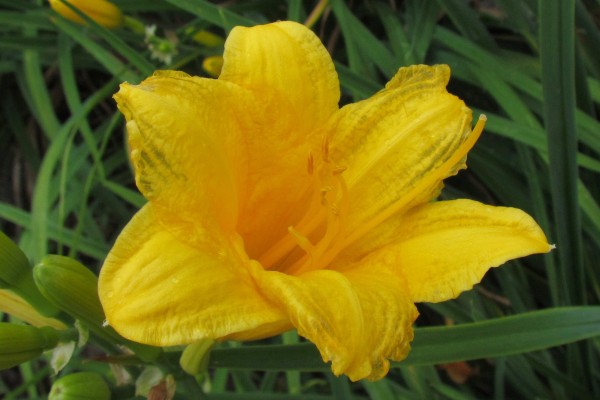
A Deteriorating Stella de Oro Flower at 4 p.m., Harrisonburg, VA, USA (26-Jun-13; © Richard L. Bowman)
As usual, unless ants attach them too badly, the Vinca's we planted are doing very well. They form a row of red and pick color in front of the golden yellow of the Stella de Oro Daylily flowers.
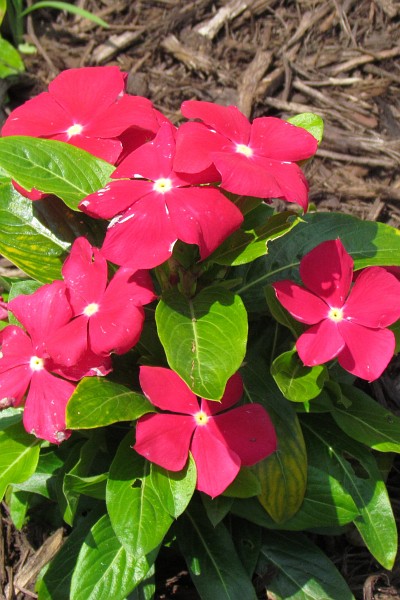
A Vina Plant in Bloom, Harrisonburg, VA, USA (25-Jun-13; © Richard L. Bowman)
But I had to try for a close up of the center of the Vinca flower. (The common names for this can be "lesser periwinkle" or "dwarf periwinkle.") Since I have put my thumb in any of these photos, let me put the size of the flowers in perspective for anyone who has not grown Vinca plants. The flowers are nearly 2 inches (5 cm) in diameter. The dark spot (really a hole) at the center is tiny--1 mm or less (or about 1/32 of an inch).
Below is the close-up photo showing clearly that the tiny dark spot is really a hole into a cylinder with many fine hairs surrounding and in it. This is the opening to the corolla tube inside of which all of the sexual reproduction apparatus and activites take place.
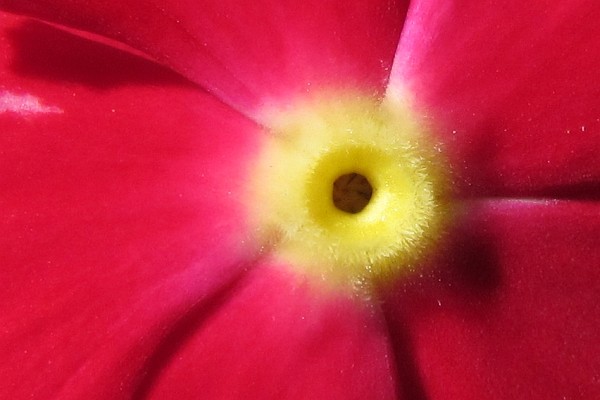
Close-up of the Opening to the Corolla Tube at the Center of aVinca Bloom, Harrisonburg, VA, USA (26-Jun-13; © Richard L. Bowman)
The tiny opening shown above attaches to the stem on the underside of the flower. Notice below the bulge on the outside indicationg the ovaries and other apparatus are on the inside.
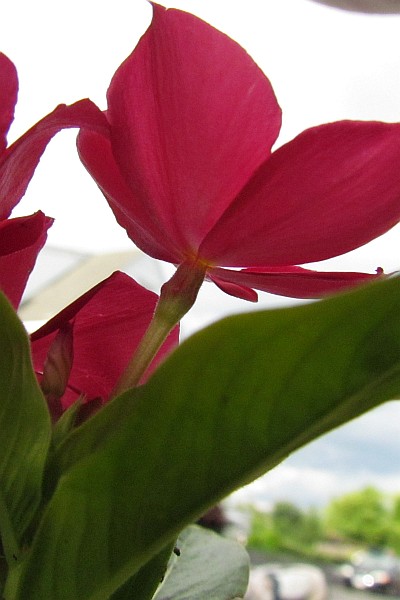
Underside of a Vinca Bloom, Harrisonburg, VA, USA (27-Jun-13; © Richard L. Bowman)
Ah, it was worth the time and energy getting these photos. Nature is sure intricate. I thank God for that!
Crownvetch, described by the USDA as "a useful but overused erosion control plant," is essentially a weed in our home setting. But, as you will know by now, if you have viewed my blog for any length of time, I think weeds can be beautiful, too.
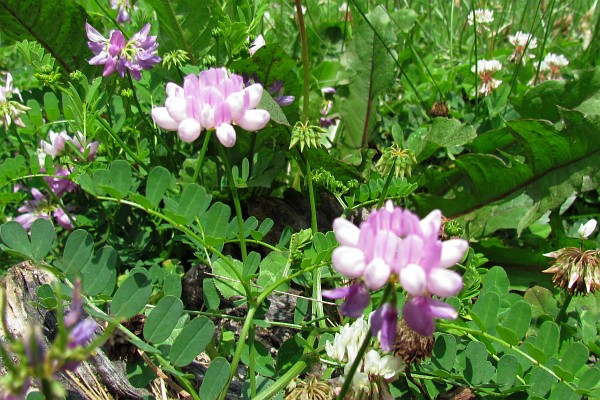
Crownvetch Plant and Flowers, Harrisonburg, VA, USA (19-Jun-13; © Richard L. Bowman)
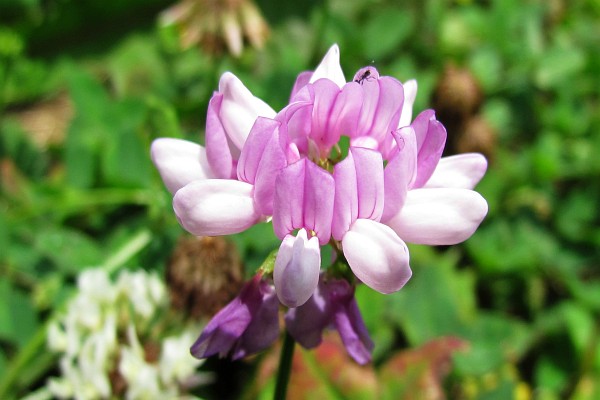
Close-up of Crownvetch Flower, Harrisonburg, VA, USA (19-Jun-13; © Richard L. Bowman)
And then I'll put my thumb into the picture, too, so one can get a sense of the size of the flower head.
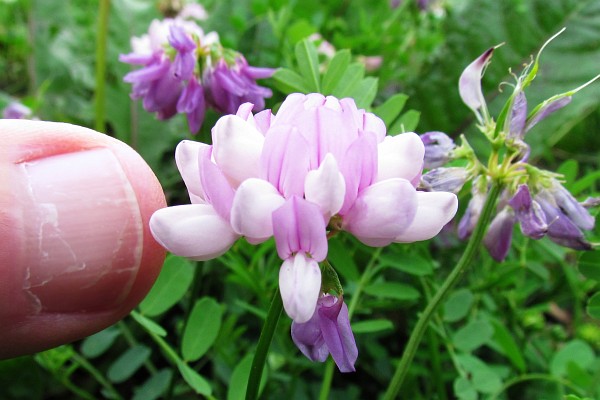
Close-up of Crownvetch Flower (with thumb), Harrisonburg, VA, USA (19-Jun-13; © Richard L. Bowman)
I will admit that the file name of the first picture I found on Google that matched the flowers I'm posting today put me in a German mode. The file title was "Million_Bells_in_rot_und_gelb.JPG" and means "Million Bells in red and yellow." So here is a phto of the flower box on the railing of our deck.
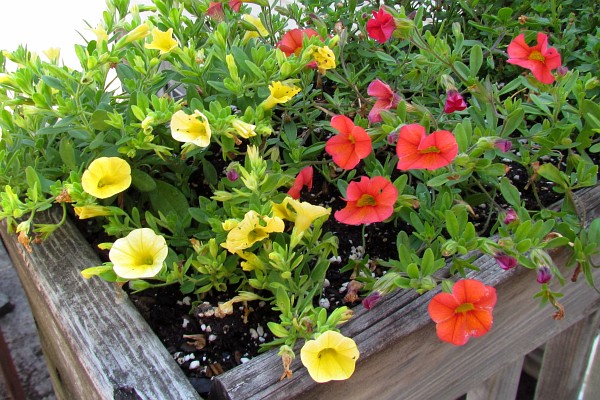
Million Bells in our flower box, Harrisonburg, VA, USA (15-Jun-13; © Richard L. Bowman)
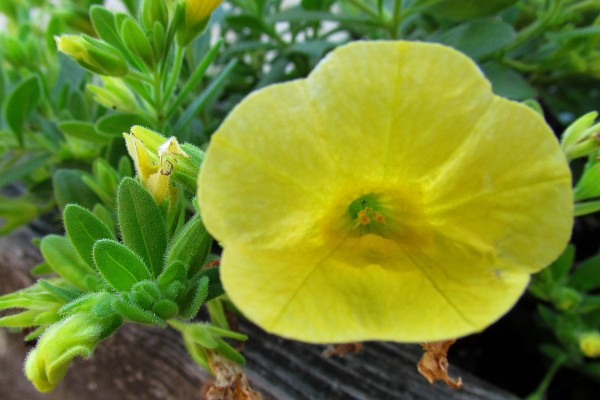
Close-up of yellow Million Bells flower, Harrisonburg, VA, USA (15-Jun-13; © Richard L. Bowman)
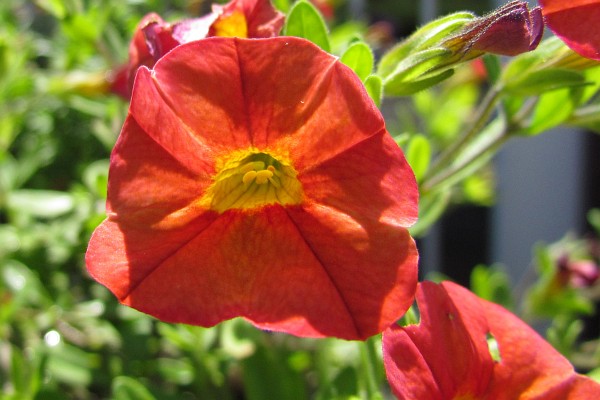
Close-up of red Million Bells flower, Harrisonburg, VA, USA (15-Jun-13; © Richard L. Bowman)
And for comparison in size, here is a photo of my thumb next to one of the red blooms.
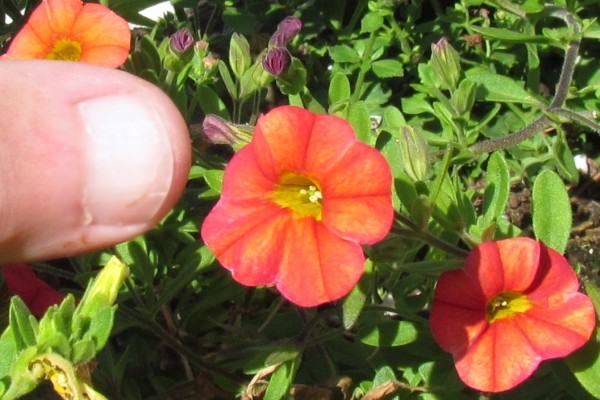
Close-up of red Million Bells flower (with thumb), Harrisonburg, VA, USA (15-Jun-13; © Richard L. Bowman)
Did you notice that each flower has five petals but that they are fused together. Also, they are usually not very circular but may be more oval or even an oval with one side flattened. Imperfect becomes the beautiful norm!
If you are interested in more info about the Million Bells flowers, such as the fact that "the first cultivars [were] released in 1992, visit the Proven Winners web site.
I also like Roses very well. The light colored ones--white and yellow, particularly--are more susceptible to showing any imperfections. But even so, they are beautiful.
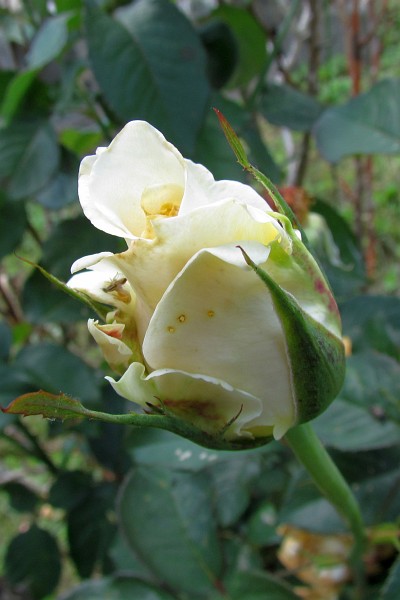
Close-up of White Clover flower with labels, Harrisonburg, VA, USA (12-Jun-13; © Richard L. Bowman)
OK, maybe you are still wanting a translation of the title of this blog today. It is: "Imperfect Is Also Very Good!" I am very thankful that God agrees with this and that I (and all of us) can know his love in spite of how imperfect I am (or we are)!
First I'll show the weed; at least some people would call it that. In the last week, however, I have seen many lawns (in additon to ours) with almost a carpet of White Clover flowers. Up close they are kind of special.
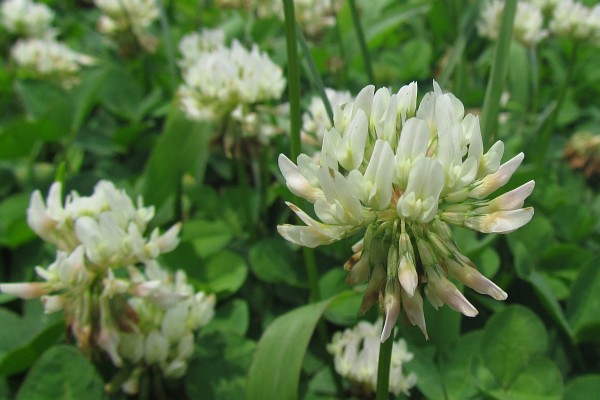
White Clover flower headt, Harrisonburg, VA, USA (12-Jun-13; © Richard L. Bowman)
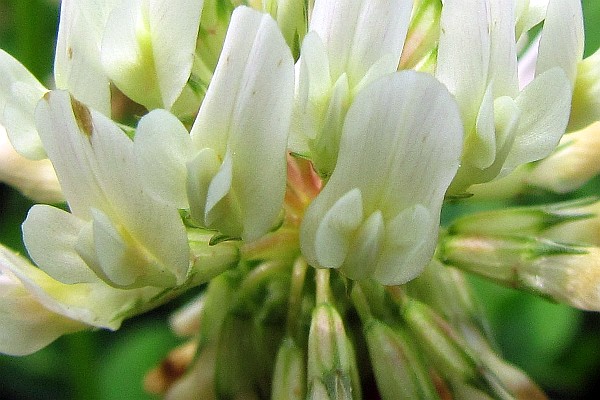
Close-up of White Clover flowers, Harrisonburg, VA, USA (12-Jun-13; © Richard L. Bowman)
Note the five petals of each flower which are labeled below--the large banner, the two medium sized wings and the smaller keel (from two petals fused together). Inside the keel are the stamens and pistil of each flower.
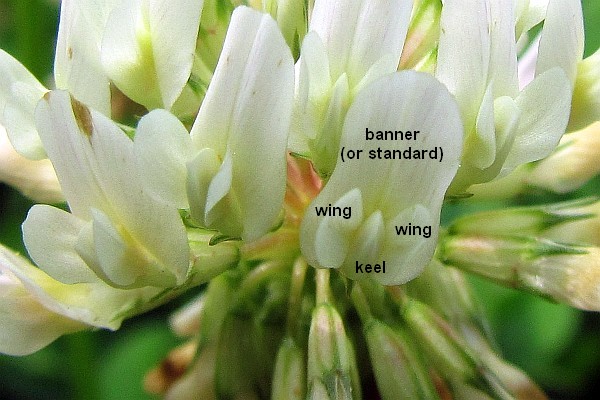
Close-up of White Clover flower with labels, Harrisonburg, VA, USA (12-Jun-13; © Richard L. Bowman)
Secondly is an old-time favorite of gardeners (indoor and outdoor)--the Geranium.
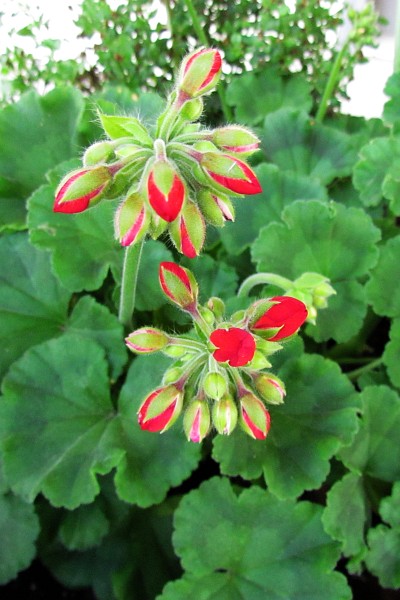
Geranium flower buds, Harrisonburg, VA, USA (12-Jun-13; © Richard L. Bowman)
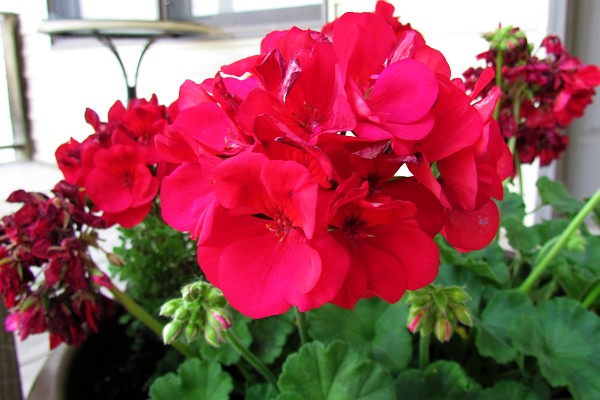
Geranium flower head, Harrisonburg, VA, USA (12-Jun-13; © Richard L. Bowman)
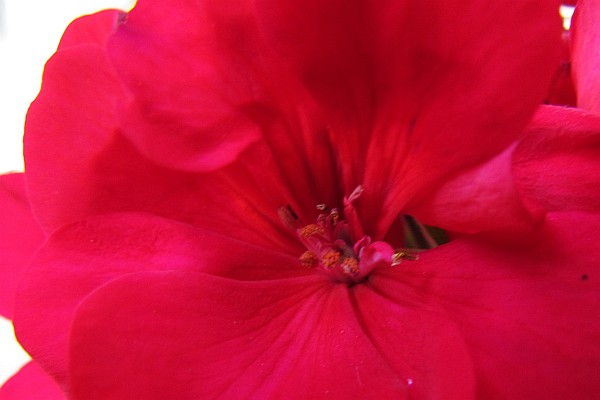
Close-up of a single Geranium flower, Harrisonburg, VA, USA (12-Jun-13; © Richard L. Bowman)
More to come, I'm sure!
Well, my trusty expert, Dr. Ed Lickey, identified the plant with the yellow flowers I posted on June 6 as Lysimachia nummularia . Common names include "Creeping Jenny" and "Moneywort."
At the request of our daughter Jennifer Bowman Sauder, I am including a photo of my thumb--OK, I mean--my thumb and the flowers to give a visual clue to the small size of these plants. I will admit that if I do this more often I better have a manicure!!
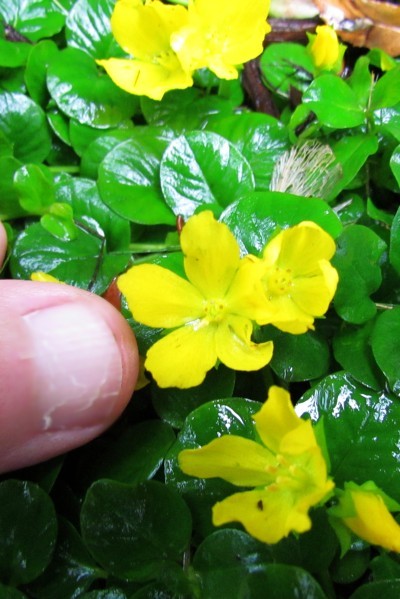
Creeping Jenny, Harrisonburg, VA, USA (13-Jun-13; © Richard L. Bowman)
If you are interested in more information on this perennial, check out these sites.
Note that while this plant can be purchased as a bedding plant, it is also considered an invasive plant and weed by some experts.
We had such nice rain on Thursday and Friday (a bit over two inches [5 cm] in about 36 hours) and such nice sunshine (and a touch of rain) today that the flowers and I both bloomed today. So here are a few more photos form this afternoon.
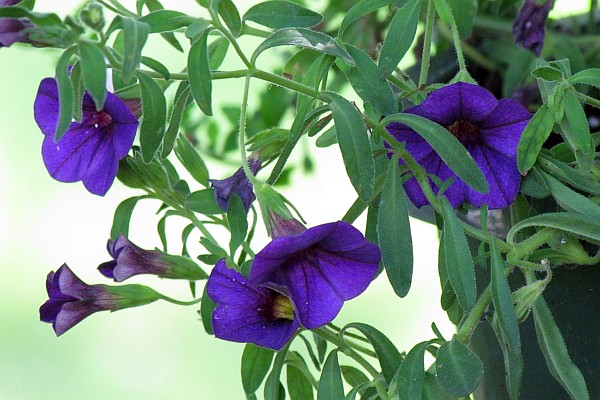
Petunias in a hanging pot, Harrisonburg, VA, USA (9-Jun-13; © Richard L. Bowman)
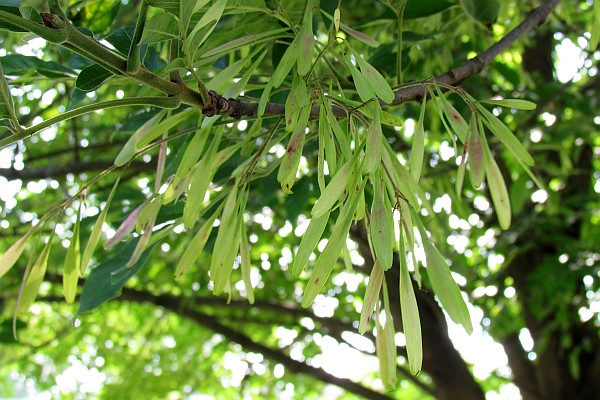
Ash Tree "blooms", Harrisonburg, VA, USA (9-Jun-13; © Richard L. Bowman)
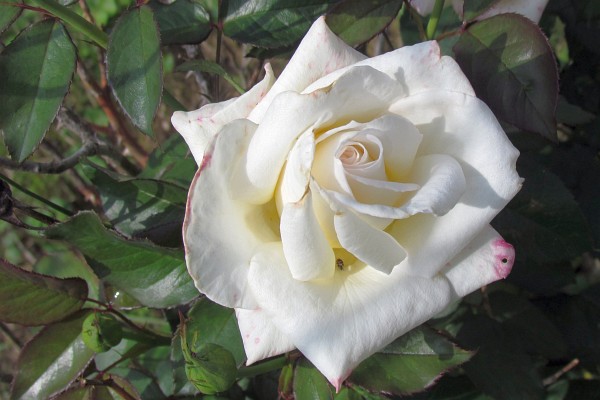
A Rose, Harrisonburg, VA, USA (9-Jun-13; © Richard L. Bowman)
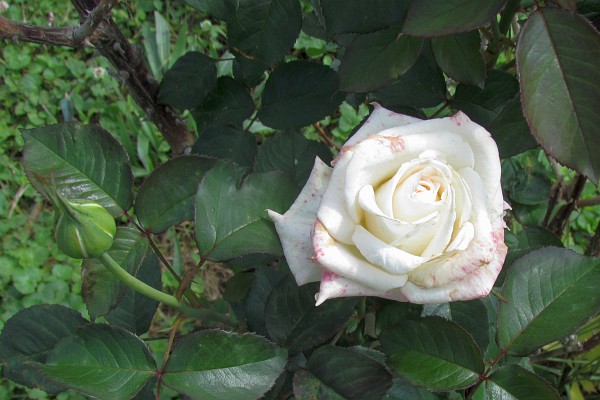
A Rose and a bud, Harrisonburg, VA, USA (9-Jun-13; © Richard L. Bowman)
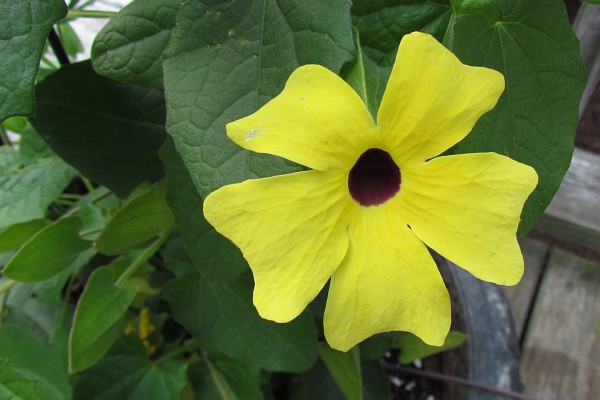
Black-eyed Susan, Harrisonburg, VA, USA (9-Jun-13; © Richard L. Bowman)
More to come, I'm sure!
This challenge by Jesus is from Matthew 6:28 in the King James Version. The more recent New International Version puts it this way: "And why do you worry about clothes? See how the flowers of the field grow. They do not labor or spin. Yet I tell you that not even Solomon in all his splendor was dressed like one of these."
Looking at the Stella de Oro Daylilies this morning, which had just begun to bloom overnight, I understand a fresh Jesus' challenge.
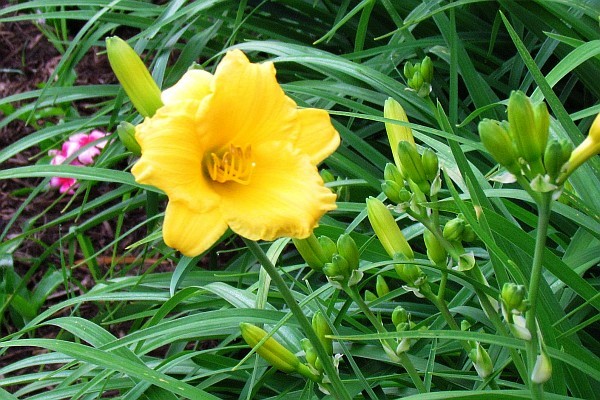
Stella de Oro Daylily (I), Harrisonburg, VA, USA (9-Jun-13; © Richard L. Bowman)
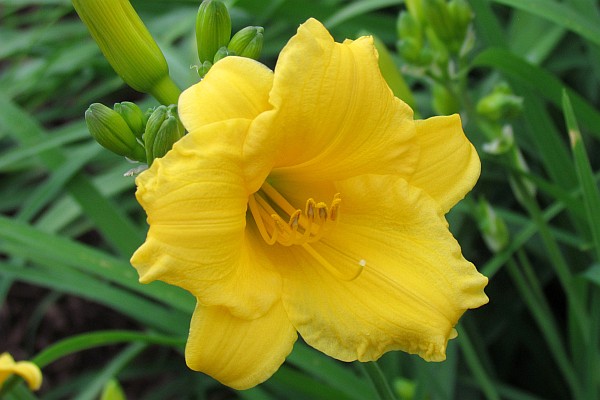
Stella de Oro Daylily (II), Harrisonburg, VA, USA (9-Jun-13; © Richard L. Bowman)
Our 13-foot (4-m) row along the north side of our deck should bloom for most of the summer. And I am looking forward to it!!
And we are sure glad to see the rain. After a nice wet spring, our weather for the past month or so has been pretty dry. Today we are getting some rain. Thank God!
The Petunias glisten in the rian.
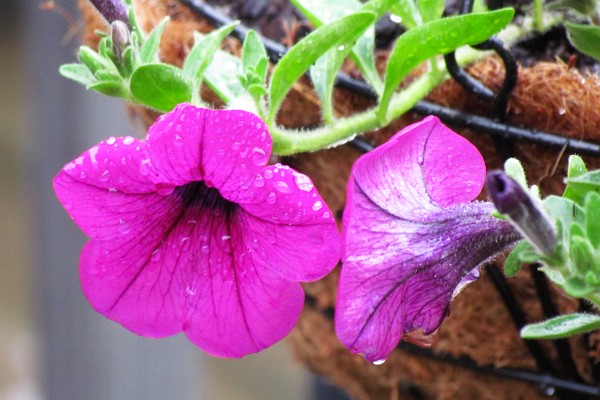
Verbena (#1), Harrisonburg, VA, USA (3-Jun-13; © Richard L. Bowman)
"Let it rain; let it rain!"
I really like the color and aliveness that flowering plants bring to the flowerbeds spread around our house and yard. However, I'm not as excited about keeping the creeping grasses and other weeds out of those beds. But here are a few photos of these plants that have caught my eye here near the beginning of summer.
First of all, here are two different varieties of Verbena plants in bloom.
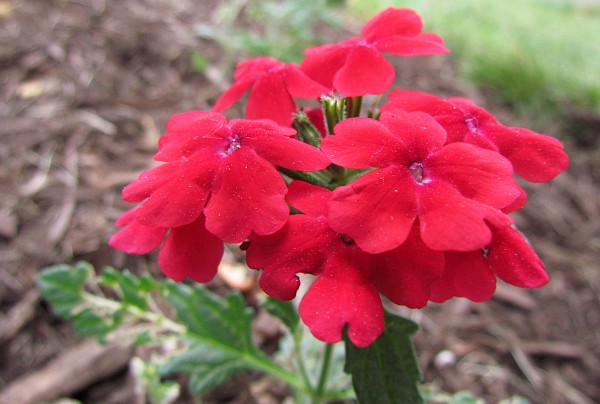
Verbena (#1), Harrisonburg, VA, USA (3-Jun-13; © Richard L. Bowman)
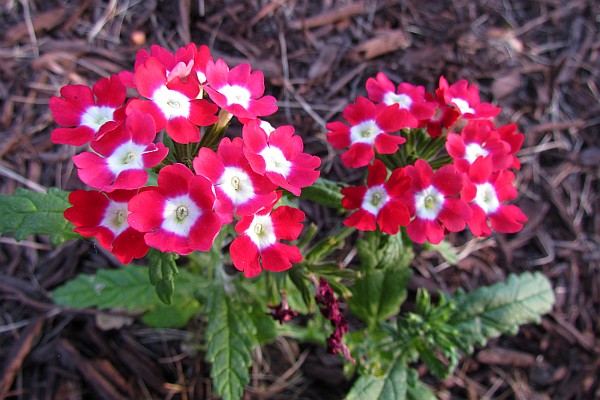
Verbena (#2), Harrisonburg, VA, USA (5-Jun-13; © Richard L. Bowman)
On the shady side of our porch steps, we have two Coral Bells (Heuchera) plants. I'm always impressed when they produce a spike of very small flowers for a plant with good sized leaves. Now if I could only get a good close-up of the flowers. That is a project I'll have to keep working on.
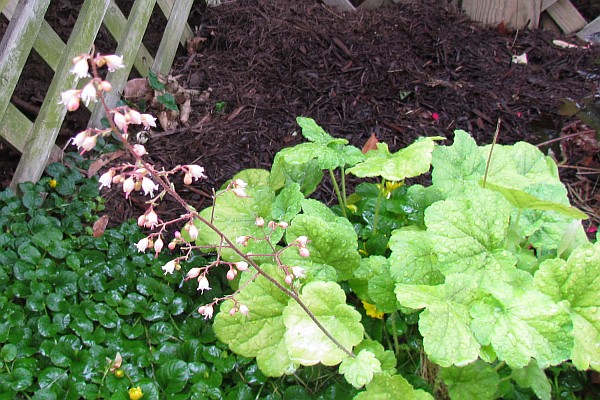
Coral Bells, Harrisonburg, VA, USA (6-Jun-13; © Richard L. Bowman)
Mint tea made from fresh garden mint is always a treat for me, but while the plants are growing nicely again this year, I still have yet to make any tea.
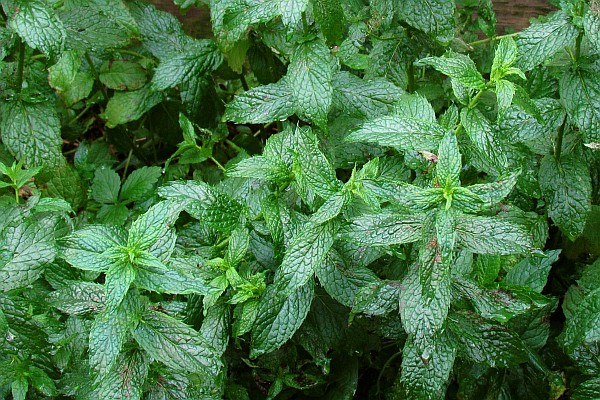
Spearmint, Harrisonburg, VA, USA (3-Jun-13; © Richard L. Bowman)
While you sit back and enjoy a glass of ice-cold mint tea, consider the identification of the plant and flowers below.
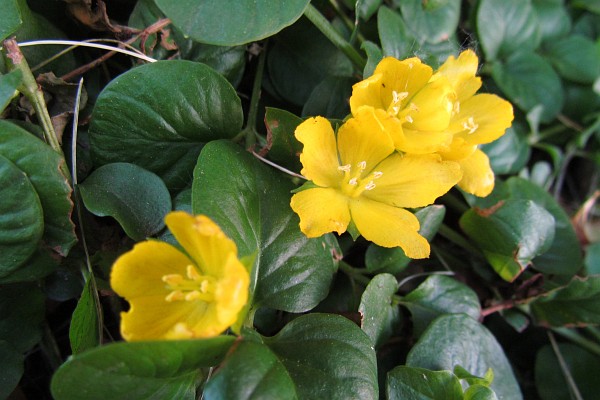
Blaze Climbing Rose bush, Harrisonburg, VA, USA (31-May-13; © Richard L. Bowman)
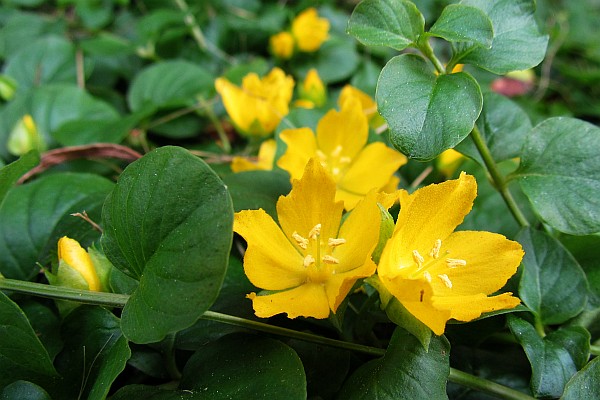
Blaze Climbing Rose blooms, Harrisonburg, VA, USA (31-May-13; © Richard L. Bowman)
We planted two of these plants a couple of years ago in the flower beds in front of our porch (to the East), and they have taken to spreading. This year they have produced an abundance of lovely small yellow blooms about a half inch (~1.5 cm) in diameter.
--©2013, Richard L. Bowman